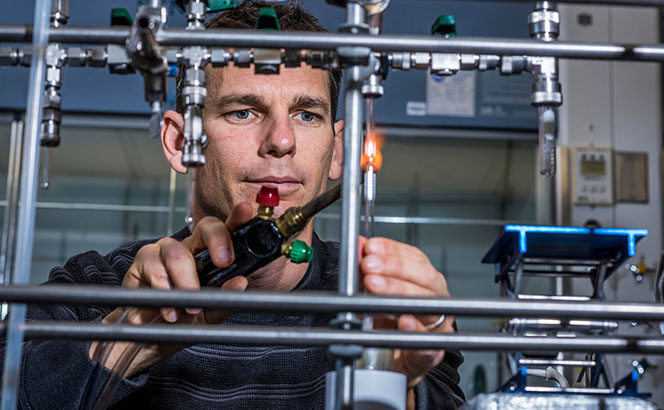Well known among the global scientific community for his research on the vast amounts of carbon stored in rapidly thawing permafrost soil – and its potential threat to the environment – Ted Schuur, professor of NAU’s Center for Ecosystem Science and Society, has spent nearly 20 years working to bring awareness to the issues revealed by his scientific findings.
Schuur has published his results in several prestigious, peer-reviewed scholarly journals, including Nature and Nature Climate Change. Along with his colleagues, he has also been awarded several million dollars in grants from federal agencies such as the U.S. Department of Energy and NASA.
But a new article published in the December 2016 issue of Scientific American magazine, a popular science publication that reaches 9 million readers worldwide, is likely to have a much broader impact on the public’s understanding of this environmental challenge.
Schuur’s article, titled “The Permafrost Prediction,” discusses how the release of carbon stored in the soil of the thawing Arctic tundra has the potential for speeding up climate change. Based on field studies near Denali National Park in Alaska, as well as on research conducted by his colleagues, Schuur has found that permafrost soil is thawing more quickly than ever across the Arctic region because of rising temperatures fueled by greenhouse gases. As the soil thaws, microbial activity decomposes plant and animal remains stored there, releasing even more carbon dioxide and methane into the atmosphere.
The magazine’s editor invited Schuur to write the article because of his expertise and his reputation among climate scientists. Schuur is the lead investigator for the Permafrost Carbon Network, an international consortium of more than 300 researchers that shares findings about permafrost carbon and its potential danger. The global network synthesizes science results for reports, agency briefings and media interviews to inform decision makers and the wider public.
“In the expert judgment of the network’s members,” explained Schuur, “the Northern Hemisphere’s vast permafrost zone contains an estimated 1,450 billion metric tons of carbon in the top three meters of frozen soil – about three times more than all the carbon ever emitted by human activity in modern times. Even if only 10 percent of that carbon pool is released this century, most of it as carbon dioxide, it means that 130 billion to 160 billion metric tons of additional carbon would enter the atmosphere, accelerating global warming. As a result, permafrost thaw will make climate change happen even faster than scientists have projected based on emissions from human activities alone.”
Schuur’s findings informing public policy at both national and international levels
Schuur and his colleagues are increasingly finding opportunities to inform policymakers and decision makers, but they also recognize the need to make the public aware of the issues.
“As scientists who care about the environment,” Schuur noted, “we need to share our findings beyond the scientific community if we are going to change environmental policies affecting the future of our planet.”
Schuur’s findings were referenced by President Obama during his remarks at the 2015 GLACIER Conference in Anchorage, Alaska. Schuur is currently leading a team contributing research findings to the State of the Carbon Cycle Report to be issued by the U.S. Carbon Cycle Science Program in 2017.
On an international level, Schuur is one of only five scientists from the U.S. recently nominated by the Intergovernmental Panel on Climate Change (IPCC) to contribute to a special report on Climate Change and Oceans and the Cryosphere. IPCC assessments, which draw on the work of hundreds of scientists from all over the world, are widely recognized as the most credible sources of scientific information on climate change, and are used by participants in the Paris Agreement by the United Nations Framework Convention on Climate Change.



